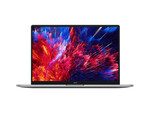Xiaomi RedmiBook Pro 14 2022, i5-12450H MX550
Specifiche tecniche

Price comparison
Media dei 2 punteggi (dalle 2 recensioni)
recensioni per Xiaomi RedmiBook Pro 14 2022, i5-12450H MX550
Sorgente: The Indian Express
 EN→IT
EN→ITAs a daily driver, this is a good laptop with ample storage and RAM to handle most tasks efficiently. But at Rs 74,999, Xiaomi’s Notebook Pro 120G takes on other similar options, such as the HP Pavilion Plus 14 (this one doesn’t have a 120Hz display), the Asus Zenbook 14 OLED (90 Hz display), and Dell’s new Inspiron 15 series (120 Hz display). Most of these laptops are in a similar price bracket, with the same 16GB RAM and 512GB storage space, as well as the Intel Core i5 (12th generation processor), though Asus is the most expensive at Rs 89,999. So Xiaomi is evenly matched in terms of competition from other brands. Xiaomi also has an option at Rs 69,999, which has the same specifications, but without the Nvidia MX550 for graphics. The biggest challenge for Xiaomi will be to convince buyers that their laptop has the best to offer, which might not be easy considering the competition in the market.
Singola recensione, disponibile online, Medio, Data: 09/17/2022
Valutazione: Punteggio totale: 80%
Sorgente: The Times of India
 EN→IT
EN→ITFor less than Rs. 80,000, the Xiaomi Notebook Pro 120G ends up being a solid midrange Windows laptop to consider, if your primary usage is work-related. It is built nicely, has a good display that only enhances its appeal with the 120Hz refresh rate, solid and flawless performance, as well as a good choice of I/O ports. The standard model at Rs. 69,999 should be a good pick for most users, while the NVIDIA MX550 GPU equipped version at Rs. 74,999 is great for casual gamers and budding creative users. That said, it is not all good. Battery life is an issue on the Xiaomi Notebook Pro 120G and you need to tow that charger in the backpack. The webcam could have been better and the speakers louder. But then you look at the competition and the Xiaomi Notebook Pro 120G ends up being a solid laptop in comparison. The Asus VivoBook S15 for the same price only offers a larger 15.6-inch OLED display but misses out on a discrete GPU – not a package for everyone. That makes the Xiaomi Notebook Pro 120G the best Core i5 midrange laptop we have seen in 2022.
Singola recensione, disponibile online, Medio, Data: 09/14/2022
Valutazione: Punteggio totale: 80%
Commenti
NVIDIA GeForce MX550:
Scheda grafica dedicata entry level basata sul TU117 con memoria GDDR6.
Ridurre la distanza delle Schede Grafiche per gli utenti che vogliono utilizzare il videogiochi. I nuovi giochi dovrebbero funzionare su queste schede, ma con riduzione dei dettagli e risoluzione mediocre.
>> Ulteriori informazioni le potete trovare nel nostroConfronto delle schede grafiche e nella nostra Lista dei Benchmark.
i5-12450H: CPU mobile basata su Alde Lake con 4 core ad alte prestazioni e 4 core efficienti. I core ad alte prestazioni offrono l'hyper threading, che porta a 12 thread che possono essere elaborati. La CPU ha un clock da 1,5 a 4,4 GHz e supporta vPro.
>>Ulteriori informazioni le potete trovare nel nostroConfronto dei processori per portatili.




